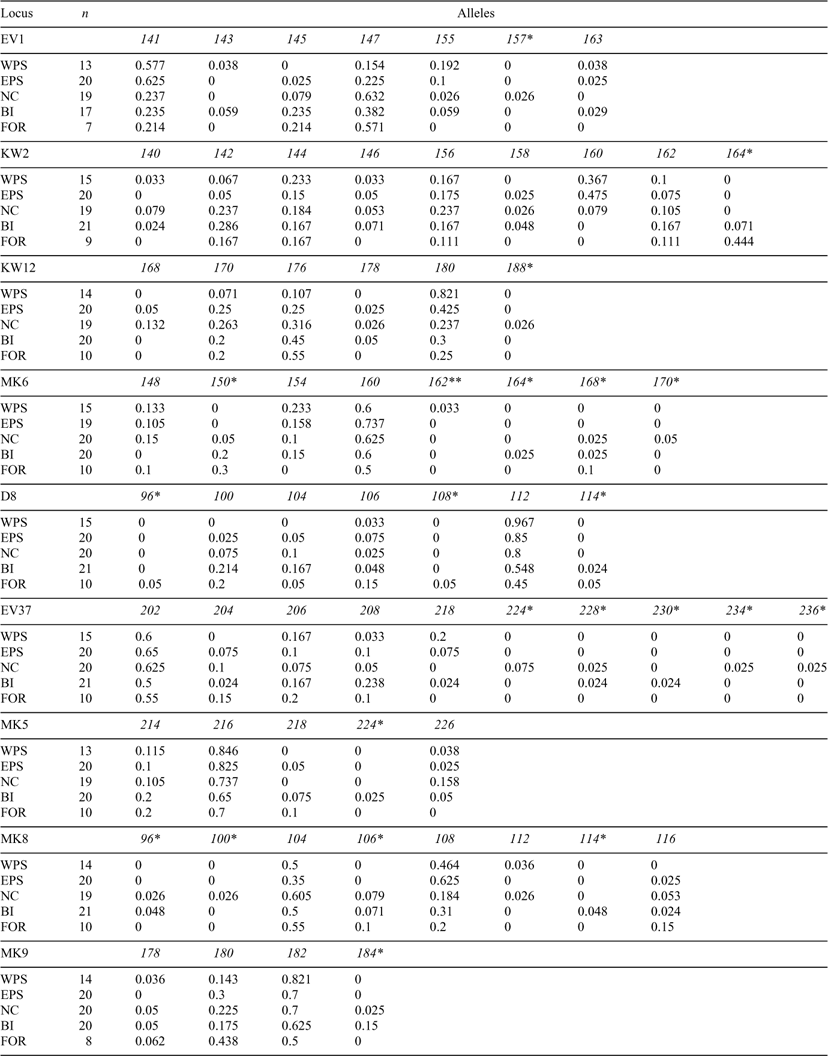Habitat type promotes rapid and extremely localised genetic differentiation in dolphins
Luciana M. Möller A B C , Joanna Wiszniewski A B , Simon J. Allen A and Luciano B. Beheregaray BA Marine Mammal Research Group, Graduate School of the Environment, Macquarie University, NSW 2109, Australia.
B Molecular Ecology Group for Marine Research, Department of Biological Sciences, Macquarie University, NSW 2109, Australia.
C Corresponding author. Email: luciana.moller@gse.mq.edu.au
Marine and Freshwater Research 58(7) 640-648 https://doi.org/10.1071/MF06218
Submitted: 20 November 2006 Accepted: 21 May 2007 Published: 27 July 2007
Abstract
The high potential for dispersal of many marine organisms often results in low population differentiation over large distances. Here, we report that dolphin communities living in very close geographic proximity (<16 km) but in two different environments – open coast and enclosed embayment – exhibit unexpected genetic differentiation at nine microsatellite loci. Results based on a fixation index and a Bayesian clustering approach suggested that gene flow between communities within an embayment is high, as is gene flow between coastal communities. However, lower gene flow between embayment and open coast communities translated into substantial genetic differentiation between dolphin communities from the two environments, and assignment of individuals into two populations. Along with patterns observed in 403 bp of the mitochondrial DNA control region, the results suggest that restriction of gene flow likely occurred in the last 6000 years, after coastal dolphins colonised the embayment. We hypothesise that factors such as fidelity to the local area and resource and behavioural specialisations may have played a major role in promoting and maintaining genetic subdivision between dolphins of the two environments. Importantly, our study shows that habitat type can rapidly promote extremely fine-scale genetic structure in a long-lived, highly mobile marine mammal.
Additional keywords: dispersal, Indo–Pacific bottlenose dolphin, phylogeography, population genetics, Tursiops aduncus.
Acknowledgements
Financial support was provided by Macquarie University. We thank O. and L. Griffiths for fieldwork support. J. Powell, A. Caccone, F. Balloux and P. Sunnucks provided comments on an earlier draft of the manuscript. This work was conducted under licence from the NSW Department of Environment and Conservation and approved by the Macquarie University Animal Ethics Committee.
Balloux, F. , and Lugon-Moulin, N. (2002). The estimation of population differentiation with microsatellite markers. Molecular Ecology 11, 155–165.
| Crossref | GoogleScholarGoogle Scholar | PubMed |
Defran, R. H. , and Weller, D. W. (1999). The occurrence, distribution, and site fidelity of bottlenose dolphins (Tursiops truncatus) in San Diego, California. Marine Mammal Science 15, 366–380.
| Crossref | GoogleScholarGoogle Scholar |
Gaggiotti, O. E. , Lange, O. , Rassmann, K. , and Gliddon, C. (1999). A comparison of two indirect methods for estimating average levels of gene flow using microsatellite data. Molecular Ecology 8, 1513–1520.
| Crossref | GoogleScholarGoogle Scholar | PubMed |
Hale, P. T. , Barreto, A. S. , and Ross, G. J. B. (2000). Comparative morphology and distribution of the aduncus and truncatus forms of bottlenose dolphin Tursiops in the Indian and Western Pacific Oceans. Aquatic Mammals 26, 101–110.
Möller, L. M. , Allen, S. J. , and Harcourt, R. G. (2002). Group characteristics, site fidelity and abundance of bottlenose dolphins (Tursiops aduncus) in Jervis Bay and Port Stephens, southeastern Australia. Australian Mammalogy 24, 11–21.
Möller, L. M. , and Beheregaray, L. B. (2001). Coastal bottlenose dolphins from southeastern Australia are Tursiops aduncus according to sequences of the mitochondrial DNA control region. Marine Mammal Science 17, 249–263.
| Crossref | GoogleScholarGoogle Scholar |
Rice, W. (1989). Analysing tables of statistical tests. Evolution 43, 223–225.
| Crossref | GoogleScholarGoogle Scholar |
Roy, P. S. (1984). Holocene sedimentation histories of estuaries in southeastern Australia. Western Australian Department of Conservation and Environment Bulletin 161, 23–59.
Sellas, A. B. , Wells, R. S. , and Rosel, P. E. (2005). Mitochondrial and nuclear DNA analyses reveal fine scale geographic structure in bottlenose dolphins (Tursiops truncatus) in the Gulf of Mexico. Conservation Genetics 6, 715–728.
| Crossref | GoogleScholarGoogle Scholar |
Weir, B. S. , and Cockerham, C. C. (1984). Estimating F-statistics for the analysis of population structure. Evolution 38, 1358–1370.
| Crossref | GoogleScholarGoogle Scholar |




